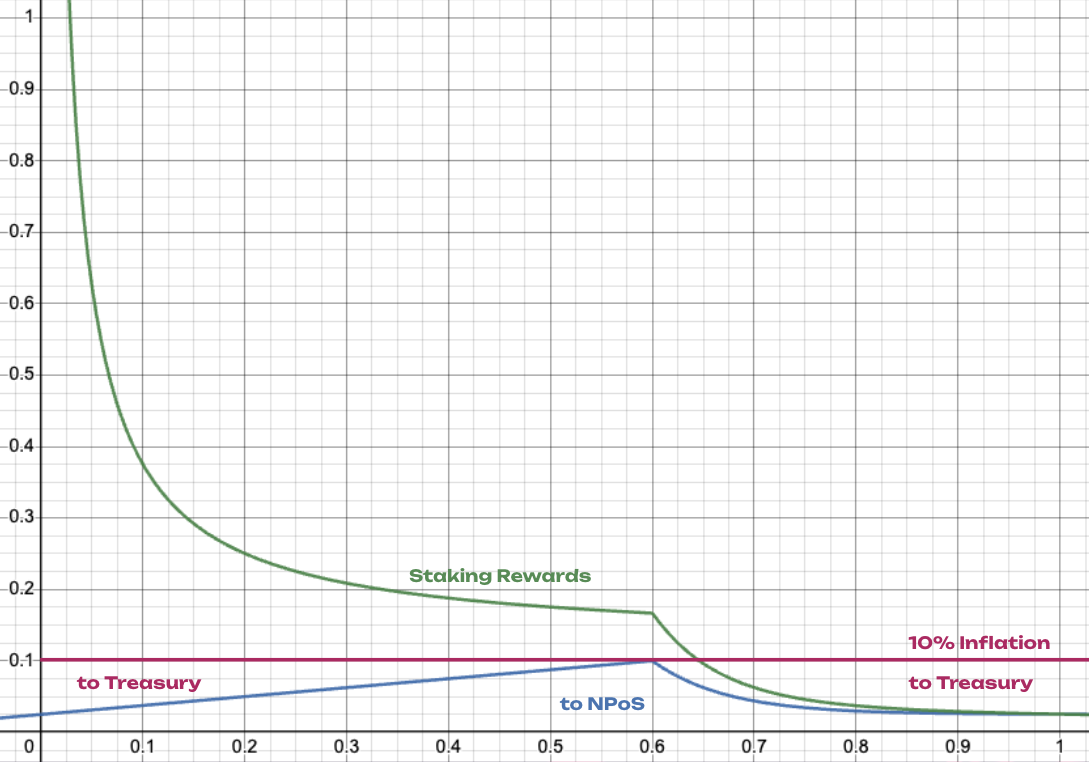Kusama Inflation
KSM is an inflationary token. Inflation is set to be 10% annually. Depending on the supply staked and the ideal staking rate (more about this below), part of the inflation is distributed to the stakers and part to the treasury.
!!!info The current KSM token supply can be seen here.
It is essential to understand that the primary objective of inflation is to incentivize network participants through Nominated Proof of Stake (NPoS) and to grow the network through funding the on-chain treasury. There is an opportunity cost of keeping the number of tokens idle with the current inflation model as the tokens get diluted over time. Economics and game theory suggest that setting an ideal inflation rate is essential for incentivizing the network participants as well as the growth of the network, and any deviation from it can have adverse effects. Reducing the inflation rate could limit growth, while increasing the inflation rate could break the incentive model of the token. Hence, token inflation rate is not a forever fixed value, and inflation can be updated in the future through on-chain governance based on thorough tokenomics research.
Kusama Inflation Model¶
The chart below shows the inflation model of the network. Depending on the number of staked tokens, the distribution of the inflation to validators and nominators versus the treasury will change dynamically to provide incentives to participate (or not participate) in staking.
There is a dynamic ideal staking rate (in the figure set to 0.6 or 60%) that the network tries to maintain. The inflation model will incentivize network participants to stake when the current staking rate < ideal staking rate and disincentivize staking when current staking rate > ideal staking rate. The goal is to have the staking rate meet the ideal staking rate. The current staking rate would be the total amount staked in the current era over the total token supply, where the total amount staked is the stake of all validators and nominators on the network. The ideal staking rate accounts for having sufficient backing of tokens to prevent the possible compromise of security while keeping the native token liquid.

More information here.
- x-axis: Proportion of staked tokens
- y-axis: Annualized percentage (inflation and staking rewards, see below)
- Blue line: Annual inflation rate diverted to NPoS, i.e., the total amount of tokens minted to pay validators and nominators. For instance, 0.1 corresponds to 10% of token inflation diverted to stakers. Since annual token inflation is 10%, all inflation is used to pay validators and nominators, and 0% of token inflation is diverted to the treasury.
- Green line: Annual rewards rate for stakers. For instance, 0.2 corresponds to 20% of annual returns on the staked tokens. You can determine the current annual staking rewards rate by looking at the top bar of the staking overview on the Polkadot Staking Dashboard.
Assuming that the ideal staking rate is 60%, all of the inflation would go to the validators and nominators if 60% of all tokens are staked. Any deviation from the 60% - positive or negative - sends the proportional remainder to the treasury. Deviations from the ideal staking rate are referred to as staking inefficiencies. Thus, the treasury does not receive an inflow of funds from inflation when the system staking rate equals the ideal staking rate. See this page for more information about treasury inflow sources.
For those who are interested in knowing more about the design of the inflation model for the network, please see here.
Ideal Staking Rate¶
The ideal staking rate can vary between 45% to 75% based on the number of parachains that occupied a core (this excludes the system parachains), based on the implementation here.
Briefly, the ideal staking rate can be calculated as follows:
0.75 - auction_proportion
where auction_proportion is obtained by computing min(auctioned_slots, 60) / 300. The
auctioned_slots are all the auctioned slots (or cores) without the cores for system parachains.
Assuming there are 50 filled cores, of which five are dedicated to
system parachains, there are 45 auctioned cores. The
auction_proportion is thus 45 / 300 = 0.15. The ideal staking rate is 0.75 - 0.15 = 0.6.
If the amount of tokens staked goes below 60%, then staking rewards for nominators increase, incentivizing them to stake more tokens on the network. On the contrary, staking rewards drop if staked tokens exceed the ideal staking rate. This results from the change in the percentage of staking rewards that go to the Treasury.